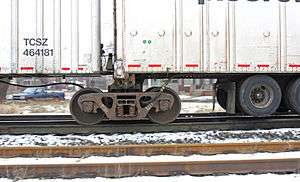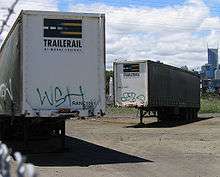Roadrailer

In railroad terminology a Roadrailer or RoadRailer is a highway trailer, or semi-trailer, that is specially equipped for use in railroad intermodal service.
Overview
The advantage of using roadrailers is their ability to be used directly behind other freight (or even passenger) equipment without the use of trailer flatcars.
Roadrailers first appeared on American railroads in the 1950s. The trailers were built with integrated railroad wheelsets that could be lowered into position when the trailer was pulled behind a train. More modern roadrailers do not include integrated railroad wheels, but ride on regular trucks that do double-duty, serving as articulation points between multiple trailers in a train. Each regular truck is equipped with ONE fifth wheel at one end and a connector plate at the other end. The connector plate slides into a female receptacle on the rear of the trailer in front and is secured with a steel pin. At the head of a Road Railer train there is an adaptor truck equipped with one fifth wheel and one regular AAR Type "E" or Type "F" automatic coupler. Each semi-trailer has one king pin at each end. Because the truck (bogie) is significantly lighter than a rail flatcar or well-car, roadrailer freight trains are much lighter and therefore are more energy efficient than traditional intermodal trains.
RoadRailers were built by the Bi-Modal Corporations in the early 1980s located in West Chester Pennsylvania. The trailers were built by the Budd Corporation locally with the integration of the wheelsets and railroad braking system done at the nearby Bi-Modal factory. This was a modern up-date of C&O's Railvan used in the 1950s. The railroad wheelsets attached to the aft portion of the trailer were lowered pneumatically by activating a simple valve controller on the left rear of the trailer. To transfer from highway mode to rail mode the trailer driver would position the trailer over tracks inlaid into a paved rail yard. First the operator would activate the valve to remove the air from the airbags that supported the trailer in the highway mode. In the fully lowered or squat position, hooks which held the railwheel set up above the road surface released. Then the operator would move the valve to inflate the two large airbags used for rail mode. These rail air bags were similar to those used in passenger rail cars at this time. After being fully transferred, the trailer would be fully level and ready for connection to the next trailer in the train. A similar system was trialed in the UK, though the concept did not prove successful, partly due to the reduction in load volume required to fit inside the UK's smaller loading gauge but also due to objections by the powerful rail and road transport unions.[1][2]
Throughout the early 1980s various railroads experimented with the RoadRailer concept to determine if the equipment would be durable enough to endure railroad use. The positive attributes of the RoadRailer were its exceptionally smooth ride, light weight and low capital costs to set up a rail yard. Since no flatcars were involved, no crane systems were needed to transfer the trailers between modes. In fact during one demonstration test a train of RoadRailers was broken down in the middle of an industrial street in Portland Oregon which happened to have track in the street, demonstrating the flexibility of the system. Another note was that a RoadRailer train did not have a caboose car which at the time was still required for freight trains. A box was designed with a yellow strobe light, and equipment for monitoring air pressure through the brake line was designed to be installed in the unused coupler of the last car. Later, as cabooses were phased out, railroads moved to their current use of a similar strobe to mark the end of the train (the so-called flashing rear-end device or FRED).
In 1982, Conrail operated a route between (Railports) Buffalo, Rochester, and Highbridge (Bronx), New York, called the Empire State Xpress, operated by Bi-Modal subsidiary Road-Rail Transportation Company. The concept was to offer customers rapid freight service that would be competitive with traditional over-the-road service. Dedicated trains left Buffalo and Highbridge each evening arriving early the next morning. The line was eventually shut down after never establishing enough key customers to utilize the service.
The primary reason that the original RoadRailer concept did not catch on was the weight penalty imposed on the trailers because of the attached railroad wheelset. This was resolved in later designs which removed the integrated wheelset by having a dedicated rail bogie assembly that stayed in the rail yard, as seen today.
Triple Crown still uses them and their photo is used in this article. The "TCSZ" on the trailer is the AAR reporting mark for Triple Crown Service. The trailer number beginning with 464 indicates that the trailer was built approximately 1999-2002, and weighs only 1,000 lb (454 kg) more than a regular highway-only trailer.
Users

Roadrailers have been used in:
- United States and still are.
- India started from october 2018
- United Kingdom around the 1960s.
- Australia in the 1980s and 1990s (this operation now ceased by Pacific National; the rolling stock having been sold privately to the road transport industry).
- Austria
- Brazil
- Canada on CN. Previously run on CP.
- New Zealand experimental and discontinued.
See also
- Containerization
- Intermodal container
- Intermodal freight transport
- Nicky Line – Where some test of a road-railer bus were carried out in the 1930s
- Road-rail vehicle
- Rolling highway
References
- ↑ "Further Delay on Liners —and Roadrailers? - 23rd October 1964 - The Commercial Motor Archive". Archive.commercialmotor.com. Retrieved 29 December 2017.
- ↑ "London Edinburgh Roadrailers to Start in October? - 14th August 1964 - The Commercial Motor Archive". Archive.commercialmotor.com. Retrieved 29 December 2017.
Bibliography
- White, John H. (1985) [1978]. The American Railroad Passenger Car. Baltimore, Maryland: Johns Hopkins University Press. ISBN 978-0-8018-2743-3.
- Daniels, Rudolph (2000). Across the Continent: North American Railroad History. Indiana University Press, Bloomington, IN. ISBN 0-253-21411-4.